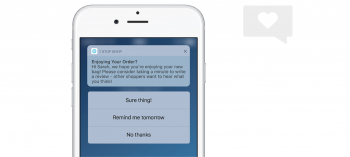Ask any retailer: losing customers is never a good thing. In many ways, this is business 101. To improve the prospects of your company – and the people who work there – while ensuring that an ever-growing customer base exists is a must. The new opportunities presented by the digital business landscape are endless. Where once you were restricted by location, you can now operate in as many different countries as you can imagine.
We are more connected now than we have ever been. Although, the same problems of old can still inevitably arise. While some companies are dealing with budgets and turnovers that dwarf their ancestors, this doesn’t absolve them from similar issues of brand loyalty and retaining customers.
As the use of the internet has grown, so has the propensity for businesses to utilize apps as well as websites; built to offer customers a more intimate online browsing experience.

Whether you’re a traditional retailer, a social media company, or a service-led operation, apps with strong software quality can act as a dedicated delivery service for what your company is all about.
When put into that context, it’s obvious that a high uninstall rate is a negative signal. Throughout this article, we’ll share some handy tips and tricks to avoid this happening to you.
Uninstall Rates: The Facts
Before we get deep into uninstall rates, it’s worth exploring how much of an issue app uninstalling is.
One in every two apps downloaded in 2020 were uninstalled within 30 days, and overall, app uninstall rates were 70% higher than in 2019. It’s also fair to say that the economic behavior of the average person has been influenced dramatically by a unique routine change caused by COVID-19.
This overbearing factor will hopefully not be around forever. And the ways of working which we have adapted to, including testing metrics in agile and delivering projects remotely, will similarly potentially decline soon.
Countries are beginning to leave lockdown, and some elements of pre-pandemic life are returning.
The stigma of a dropped call and faulty messaging software may soon be a thing of the past for your operation. Yet, ignoring the frivolousness with which some sectors are having their apps uninstalled would be to ignore the (large) elephant in the room.
Even in pre-pandemic times, the figures for e-commerce apps showed that they were enduring a higher rate of uninstalling than apps geared towards gaming and social media.

This data also confirms that the apps showing in the above graph were doing better than apps in the entertainment or travel sector. If you’re an established voice, this can be a bitter pill to swallow. If you’re a start-up who, to this point, has done everything else right in line with business advice and a startup stack, the reality of uninstallations can be devastating.
So, how to prevent this? See below for some useful tips when trying to avoid the uninstallation of your apps.
1. Simple and Effective UX
No one likes going on to a website that is overloaded by ads that pop up in an irritating, overbearing, or distracting fashion. Apps are much the same. Research shows that users are nearly 280 times more likely to climb Mount Everest than click on a banner ad.
Creating a simple and stylish place for your customers to browse will only make them want to spend more time – and money – with you. With more than half of online shoppers admitting that fast-loading pages influence their loyalty, the importance of good user experience (UX) design cannot be overstated. Once set up, utilizing automated software testing is a recommended way of ensuring this standard doesn’t dip.
Good UX design is often simple, minimalist, and inviting. Generally speaking, less is so much more. The less cluttered an app looks, the easier it is to use, and the more easy something is to use, the more likely customers are to use it.

2. Build a Community
One of the major disadvantages that online retailers face is lacking a sense of community. In a brick-and-mortar retailer, you’re likely to encounter the same faces regularly. All your senses, from the smell, to touch, are building associative links with that particular store. It increases familiarity and makes people more willing to return.
Replicating this online can be difficult, but not impossible. Brand loyalty – especially if you’re dealing in products that can amass a certain level of dedicated collectors – can inspire the creation of communities all on its own. But why not house that in your app?
Reddit, and other social media forum sites, are thriving communities. Incorporating this into your app makes it easier to check any success or failings that your most dedicated followers have found. As well as this, it allows them to create meaningful links with other customers.
With 97% of customers reading reviews before making purchases online, something in business circles which is the equivalent of “peer proofing”, these same customers are being able to moderate and engage with that conversation through the app – rather than on some exterior social platform – can give you a goldmine of feedback and opportunity.
3. Engage Directly With the User
Community engagement isn’t the only way of engaging with customers, though. Building a community depends on a certain amount of customer initiation, which isn’t something that isn’t always a solid foundation.
Taking a more proactive approach through the use of in-app notifications initiates the conversation with the customer from your side of the table. If you can personalize this message, even better. It has been found that 90 per cent of customers find marketing personalization “somewhat appealing”. Personalize your communications to bring a human element to your app.
Importantly, do not go overboard with this approach. Having an attitude in line with exploratory testing allows you to ensure you keep on the right side of the fence. It has been found that intrusive adverts and notifications can have the reverse effect on consumers’ willingness to shop with you. If you send five or more push notifications a week, you stand to lose nearly half of your prospective audience.

4. Offer Exclusives
Carrying on the theme of personalization, it may also be worth exploring offers and discounts that are exclusive to the app itself. If you operate a website, this can be especially beneficial. It gives users an incentive to download the app, rather than returning to the website.
Similarly, if you are a brand with low name recognition, getting app downloads through this strategy can lead to an increase in awareness. Owing to the fact that people are less likely to forget your name if you are taking up app space on their devices.
With nearly two-thirds of consumers listing this as a reason, to neglect this potential would be highly inadvisable. As more apps do this, expectation continues to grow. The increasing popularity of these offers is monitored and facilitated by RPA and AI. So creating and running an app that overlooks this feature will likely lead to an increase in uninstallations during a 30-day period.

5. Analyze Uninstalls
The reality is, even if you listen to all the previous advice, people are still going to uninstall your app from time to time. The reasons for this can be nothing to do with the app itself – maybe they simply need more space on their device.
If the reasons are app-specific, it’s important to know what is going wrong. Sending a quick survey out before they delete it can help to build a greater picture of why this is happening. This makes it easier to identify trends which, in turn, allows you to rectify some features of the app – or the business at large.
In a similar way to our fourth point offering exclusives, it remains crucial to not overdo this element. Making a survey or suggestion box too wordy, or too lengthy an experience is probably not a great idea. The annual “do you love us” survey is a bugbear for most consumers, so why replicate that in-app? If a customer is looking to delete your app, you don’t want the last action they take to cause unnecessary annoyance.
Conclusion
As a key function of digital businesses, apps are becoming more and more a part of a company’s retail strategy. If something is causing your customer base to abandon you altogether – often referred to as churn rate – then preventing this should be of the utmost importance, meaning great things for your business’s bottom line.




I’ve been struggling with this problem a lot lately. Initially when starting my online marketplace, I was torn between building a web app or a mobile app. I chose the latter, and I think it was a mistake because my statistics show a huge rate of uninstalling. And I honestly think that a lot of online entrepreneurs find it hard to keep their apps on clients’ phones. Thanks for such a great article. I will definitely be trying all of the tips. It’s been years since the article was posted. I wonder, do you have any info or statistics on which of the tips ended up being the most efficient one? Also, I wanted to share an article I came across while researching the best solutions for staying afloat as an online business – it’s about building a marketplace. It has some useful tips and has helped me a lot.
Hi Sarah, thanks for the comments, it’s great to hear that the article has been helpful to you and thanks for the article share on ‘How to build a website like eBay’ this is a very interesting read.
Something I’ve learned is communicating with clients when things go wrong. I know it sounds obvious but it can be tempting to hold off admitting an error and perhaps highlighting an issue. I’ve learned that it is always better to be upfront, which I’ve share in this article: https://www.alisteresam.com/post/communicatewhenthingsgowrong
We had a downtime issue which we thought would be catastrophic, and don’t get me wrong it wasn’t great but the key was how we handled the issue; we actually end up building more trust and loyalty with our client base.
As business owners we don’t always get it right and mistakes happen but communication can make all the difference.
Clients like to be in the know and sharing a light roadmap of future plans can help with churn. If clients can see that an improvement is coming and that it will impact their use of the app in a positive way, they will wait for that improvement rather than looking elsewhere.
Also, building in a feedback loop for clients to suggest improvements can also be a good way to engage and understand their needs. Feedback loops that don’t require a one on one call can yield honest feedback and engage less talkative users.